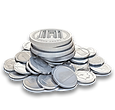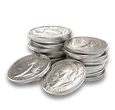How Auction Records Shape the Value of Rare Coins
- GoldsilverJapan

- Sep 30
- 5 min read
In the fascinating world of rare coins, few factors influence market prices more dramatically than auction records. These high-stakes sales are not just opportunities for collectors to acquire prized pieces—they also function as price benchmarks, psychological triggers, and trendsetters in the numismatic market.
But what exactly makes an auction result so impactful? Why do prices achieved at auction often ripple across global dealer networks, price guides, and collector mindsets for years to come?
In this long-form article, we’ll explore how auction records shape the value of rare coins, examining the mechanics behind these sales, the psychological factors at play, and real-world examples that illustrate the power of a single gavel drop.
🔍 Understanding Coin Auctions: An Overview
Coin auctions are public or private events where coins are sold to the highest bidder. They can take place in-person at prestigious venues like Heritage Auctions or Stack’s Bowers, or online via platforms like eBay or Proxibid.
Key Characteristics of Numismatic Auctions:
Transparent Bidding: All bids are visible or recorded, creating a clear price history.
Authentication: Coins are graded and certified by professional services like PCGS or NGC.
Wide Visibility: Catalogs and results are published online and cited in databases.
Competitive Pressure: The bidding environment often drives prices above market expectations.
In many ways, auctions serve as market makers in the coin world. They are where new price ceilings are set, trends emerge, and historical significance is monetized.
🧠 Why Auction Results Matter
Here’s why auction records are so influential in setting and reshaping coin prices:
1. Public Validation of Value
When a coin fetches a high price at a major auction, it sends a clear signal: someone was willing to pay this amount. This creates a new anchor point for dealers, collectors, and investors.
2. Psychological Anchoring
Auction records become mental price benchmarks. A collector who sees a 1916-D Mercury Dime sell for $30,000 in MS67 condition is now “anchored” to that number—even if other examples are available for less.
3. Scarcity Reinforcement
The more rare or one-of-a-kind a coin is, the more significant its auction history becomes. A coin that appears once every decade at auction builds a mystique—and a premium.
4. Cataloging and Resale
Auction houses often provide detailed provenance and descriptions. A coin that has “sold at Heritage for $45,000 in 2019” now carries a premium due to traceable pedigree.
🏛️ Major Auction Houses in Numismatics
Not all auction results are created equal. The weight of a record depends on the reputation of the auction house. Top-tier auction platforms include:
Heritage Auctions (USA)
Stack’s Bowers Galleries (USA)
Sotheby’s and Christie’s (Global)
Künker (Germany)
Taisei Auctions (Japan)
Spink (UK & Asia)
These firms typically offer expert grading, strong buyer networks, and global reach. Their results are seen as reliable market indicators.
📈 Real-World Examples: How Auction Records Set Market Trends
🔹 The 1933 Double Eagle: $18.9 Million
Sold by Sotheby’s in 2021
Once owned by King Farouk of Egypt
Only one example legal to own privately
This sale shattered records and ignited global interest in U.S. gold coins. The price elevated public perception of pre-1933 gold as not just a hedge, but a trophy asset.
🔹 EID MAR Denarius (42 B.C.): Over $4 Million
Ancient Roman silver coin minted by Brutus
Celebrates the assassination of Julius Caesar
This sale highlighted the power of historical narrative. Ancient coins with documented provenance and political symbolism became more desirable.
🔹 1794 Flowing Hair Silver Dollar: $10 Million+
Believed to be the first silver dollar struck by the U.S. Mint
Sold in 2013 at Stack’s Bowers
After this auction, early U.S. coinage—especially in high grade—saw a sustained surge in interest and value.
🔍 Case Study: Japanese Coin Market
In Japan, auctions hosted by Taisei, Japan Numismatic Dealers Association (JNDA), and Heritage Japan have seen rare Meiji-era and Showa-era coins breaking price records.
A few key moments:
Mutsuhito Era Yen (Year 3) coins in high grades have fetched $100,000+.
Proof coins from the 19th century, especially those never issued for circulation, have soared in price post-auction.
The Japanese coin market is also influenced by the cultural importance of imperial symbolism, historical context, and aesthetics, which auctions highlight through expert descriptions.
💸 The Role of Auction Estimates
Auction houses usually publish pre-sale estimates—low and high projections of what they expect a coin to fetch.
How estimates influence prices:
Low estimates encourage participation and optimism.
High estimates create aspirational pricing.
Exceeding estimates reinforces market momentum.
Coins that smash through high estimates often go viral in numismatic circles and are widely referenced in future sales.
💬 Collector Psychology and Auction Bidding
Let’s explore the emotional and behavioral side of coin auctions.
1. FOMO (Fear of Missing Out)
Rare coins don’t come to market often. When one does, bidders may overextend to ensure they win—especially with historic or top-population coins.
2. Status Seeking
Owning a record-breaking coin adds prestige. For high-net-worth collectors, winning auctions is as much about status as it is about investment.
3. Confirmation Bias
Buyers who see previous auction records believe future prices will be even higher, reinforcing bullish behavior.
🔍 How Auction Records Affect the Secondary Market
Once a coin sells for a high price at auction, it impacts several downstream channels:
A. Dealer Pricing
Dealers adjust their buy/sell offers to reflect recent records. For example, if an MS65 Morgan Dollar sells for $5,000, dealers nationwide update their retail pricing accordingly.
B. Online Marketplaces
Sellers on eBay and Yahoo! Auctions Japan often cite auction records in listings, anchoring their “Buy It Now” prices to past highs.
C. Price Guides
Publications like the Red Book, Numismedia, and online guides update annually or quarterly to reflect recent auction trends.
📘 Provenance and Pedigree
A coin that has sold at auction—especially at a high-profile venue—often carries more weight due to its provenance.
Famous pedigrees:
Norweb Collection
Eliasberg Collection
King Farouk’s Hoard
Bass Collection
Mentioning this history in future sales listings increases the perceived and real value.
🔁 Auction Cycles: When to Buy and Sell
Coins tend to follow auction cycles based on:
Market sentiment (e.g., inflation drives gold coin auctions)
Anniversaries (e.g., 100th year of a mint issue)
Economic outlook (recession = safe haven demand)
Smart collectors monitor upcoming auctions for coins likely to reprice the market—or for buying opportunities before the next surge.
⚖️ Auction Pitfalls: What to Watch Out For
While auction records shape the market, they’re not always reliable indicators of value.
A. Outliers
Some prices are flukes—driven by a bidding war between two aggressive collectors.
B. Fees
Buyer’s premiums (10–25%) mean final prices don’t always reflect what the seller receives.
C. Market Timing
Selling into a saturated auction can result in low bids, even for rare items.
📊 Coin Auction Trends to Watch
Fractional Gold Coins Rising: High gold prices push more collectors to chase small denominations.
Modern Rarities: Coins from the 1990s–2020s with low mintages and high grades are now fetching serious premiums.
Asian Market Expansion: Demand from Chinese and Japanese collectors is reshaping auction trends, particularly for Asian silver and gold coins.
🧭 Final Thoughts: Auctions as Market Engines
Auction records do far more than reflect coin values—they actively shape them. Whether you’re a collector, investor, or dealer, tracking auction history gives you an edge.
Key Takeaways:
Auction results are the clearest signal of market demand.
High-profile sales can elevate entire categories of coins.
Psychological and cultural forces fuel bidding behavior.
Use auction results strategically to buy low and sell high.
In the world of numismatics, auctions are where value meets narrative. And in that crucible of competition, some of the most remarkable coin prices in history are born.











Comments